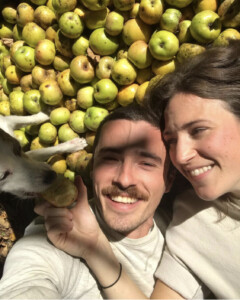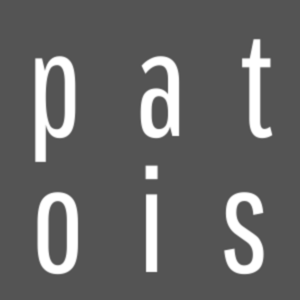Patois

Patrick Collins & Danielle LeCompte (and Artie)
About
Owners & winemakers: Patrick Collins & Danielle LeCompte
Fruit sourcing: Roughly 60% foraged apples from old abandoned orchards or wild trees, plus around 40% purchased apples and grapes
Farming practices: Foraged fruit comes from unmanaged trees, purchasing from growers working as sustainably as possible in VA (organic, unsprayed, or minimal spraying)
Soils: Granitic schist and gneiss in the Blue Ridge, limestone and shale in the Shenandoah Valley and Allegheny Mountains
Fruit varieties: Over 100 different apple varieties (heirloom varieties like Albemarle Pippin and Goldrush, crabapples, and unnamed seedlings), pears, grapes (Vidal Blanc, Seyval Blanc, Chardonel, Petit Manseng)
Annual production: 10,000 bottles
Quick facts:
- The entire Patois team, from farming to harvest to winemaking, is just Danielle and Patrick (with assists from dog Artie and baby Julien).
- For more from Danielle and Patrick about Virginia’s apple history and their work with abandoned orchards, check out their feature in The Fizz.
- On their goal for Patois: “We want people to realize that beauty is all around them! Fixed hierarchies of value undermine our ability to connect with and experience that beauty! We’re inspired by other efforts in Virginia and the East Coast writ large that listen and respond to our surroundings.”
Virginia is not an easy place to make wine. As Patrick poetically puts it, it’s “lush to the point of strangling itself,” and that’s before taking into account the sweltering summer humidity that’s a boon to grape diseases and less so to European vinifera grapes themselves. While conventional vineyards soldier on with constant tending and the liberal application of synthetic fungicide sprays, the backwoods of the Shenandoahs hide another treasure: orchards, planted decades ago and later abandoned, that have found their own equilibrium and thrive with no human intervention whatsoever.
It’s these historic orchards–“living ghosts,” as Danielle and Patrick call them–that form the backbone of the Patois project. Patrick Collins first caught the fermentation bug when he was living in Massachusetts: homebrewing was a popular hobby at the time, but instead of shipping grain from the Midwest and hops from the West Coast, he grew enamored with the idea of using the apples from old orchards nearby. He and Danielle LeCompte met after he moved to central Virginia to work at a regional cidery, and after a few years of experiments, 2019 was their first vintage release for Patois.
Patois was born as the answer to a set of constraints: “What will grow where we are, and how can we engage with that fruit without the ability to own land?” About 60% of the fruit they use each vintage is foraged from these old unmanaged orchards that are hidden throughout the Blue Ridge, Shenandoah Valley, and Allegheny Mountains. Some are heirloom varieties like Albemarle Pippin that once thrived in the region in the days before commercial production became the norm, while others are seedlings, ungrafted trees grown from seed that “exist only as themselves, uniquely genetically adapted to one spot,” as Patrick puts it. They find these sites while driving down old mountain roads or poring over historical homestead records: a handwritten note dropped in a mailbox often leads to not just a new fruit source but also beloved memories about the trees and who planted them generations ago. In addition to apples, Danielle and Patrick are purchasing hybrid grapes such as Seyval Blanc and Chardonel from growers working “as sustainably as possible in VA”–these grapes are genetically better suited to the climate here, so require fewer inputs and minimal spraying in the vineyard.
Danielle and Patrick consider themselves sparkling winemakers first and foremost, just ones who are utilizing the fruits of their particular region. Fermentation for the base wines occurs spontaneously, with no additions and minimal protection from oxygen. “We both very much enjoy the interplay of oxidative base wines with reductive secondary fermentation in bottle,” Patrick explains. “We’re trying to find a way to make complex sparkling wines outside the standard regimented, technical prescriptions: by shifting into perpetual reserve and utilizing the current vintage as our tirage, we are able to pick riper, avoid any additions, achieve a greater depth and texture, and have the best chance for a healthy native culture for extended lees aging. We want to take risks but with intention and focus, and have the flexibility to react in the moment.” They’re moving away from single-site bottlings to cuvées that “better embrace these more abstract experiences of time and place.”

